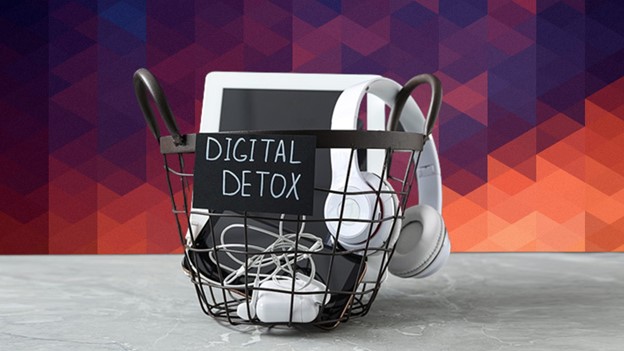
Nearly one-third of the 11,500 Americans reported engaging in digital detox daily for at least 2 hours (Statista report, 2022)
This isn’t a strong number to boast. Why?
Because it shows how most people are hooked on technology— to the point that it gets toxic.
Thus, the concept of digital detox emerged.
Let’s assume many of you have no idea about it. For this, it’s important to make you realize your addiction to the digital world. Such an addiction carries different drawbacks. The negative impacts are—
You can treat this issue with just two medications. One dose of digital detox. One dose of mindfulness practice. The combination offers benefits like—
See, how the positives here beat the negatives?
So, if you want to get rid of digital addiction, minimize ‘techs-posure’. Maximize the combo of detox and mindfulness with a bit of screen time.
Want to make the detox more effective? Get a relaxing vape like myle disposable.
Irony but let’s use the digital medium to enlighten as to this term.
A digital detox means taking a break from all the digital services. It can be— smartphones, computers, tablets, TVs, social media, digital platforms, or the internet.
So what does digital detox do?
Purpose
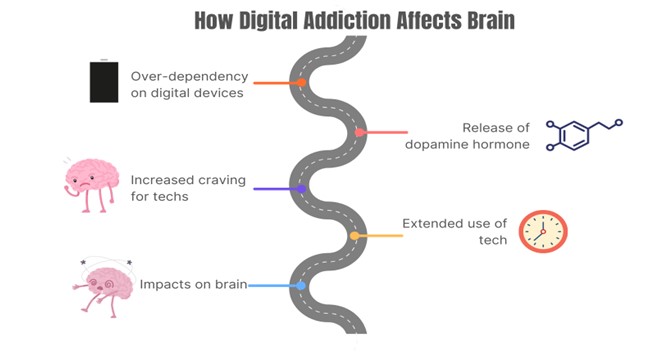
Digital addiction is like a behavioral addiction.
It occurs when you become over-dependent on digital devices. This reliance leads to compulsive behavior, like checking your phone constantly.
The science behind digital addiction originates from pleasure. Digital connectivity involves the release of endocrine and dopamine. These two work like a chemical in the brain associated with mood and emotions.
So, every time you get a notification or reaction on social media— endocrine and dopamine start their function.
“Such an addiction triggers structural changes in your brain’s reward system. It gives the brain transcendental pleasure.”
This is the reason why you constantly wish to be online.
However, the continual release of those hormonal chemicals makes you crave more. Over time, it leads to changes in your brain functions and harms them.
Thus, the same experts say—
“Digital addiction causes damage to the structure and functions of your brain’s reward, executive, and decision-making systems.”
The Effects—
Digital addiction also leaves some signs. These symptoms work to help you understand if you’re a victim.
As per studies, 50% and 90% of people who work at a computer screen have at least some symptoms.
1. Eye Strain
Eye strain originates from a condition called, Computer Vision Syndrome.
CVS happens when you spend too much time looking at screens. This triggers your eyes to work harder to see clearly and keep your eyes moist. If you continue screen timing, your eyes get tired and the blinking frequency reduces.
Consequently, it makes your eyes dry and feel strained.
The main culprit here is the high-intensity blue light emitted by screens. It increases the glare and disrupts the visual process. If your screen isn’t at the right height or there’s insufficient light, your eyes will work harder and suffer from strain.
2. Headaches
This symptom comes from eye strain.
You get headaches when— your eyes work harder to focus on the screen and your brain works hard to process constant information for longer periods. It causes muscles around your eyes and forehead to strain. As a result— headaches and migraine.
The strain mainly hits the nerves around your eyes and triggers them to send pain signals to your brain. Over time, the constant strain affects your nervous system and causes headaches.
As per a study, migraine-type headaches increased by 20-37% in one cross-sectional study with more time on screen.
3. Anxiety
This issue is associated with the stress of staying online.
Several mechanisms work that cause anxiety out of digital overload. One of them is constant connectivity.
This means—- you’re loaded with notifications, messages, and updates without pause. It makes you feel on edge as you’re always online and never get to relax completely.
Because of this, you also have this invisible pressure, which triggers you to respond quickly or stay updated. This ends up making you feel overwhelmed and anxious.
Social media can make the case even worse. It has a constant flood of information and updates which can overload your brain. Consequently, it leaves you feeling more anxious. Scenarios like these are common to increase your anxiety—
Certain behavioral indicators show when you might be experiencing digital overload.
Here are two big red flags—
Checking Phone Frequently
There’s a limit to it. Let’s say— you constantly reach for your phone to do something online, even if you don't need to.
It can be— to scroll through social media, check for a new message, or watch reels.
This is a sign of digital overload. It indicates that you’re too attached to a digital device.
An average person mainly checks their phone every 10 or 12 minutes. If the frequency is within 2 to 5 minutes, it’s an addiction.
Feeling Restless Without Devices
Sometimes you might try to stay away from the digital world, yet you can’t.
You’re not using your phone or looking at screens but feeling bored or anxious. Not just that! You struggle to relax or enjoy without the device.
Back in your head, the voice tells you to check your phone. This shows your addiction to digital services.
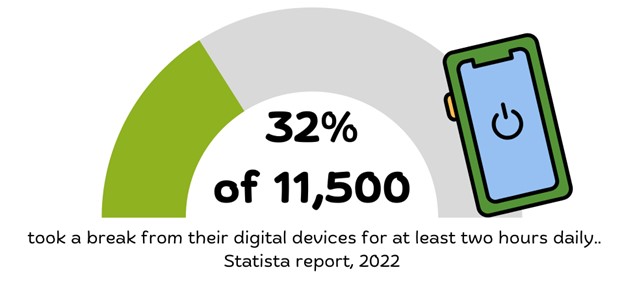 [Source: Statista]
[Source: Statista]
Many people— even experts— found how digital detox helped make a big difference in their lives.
Articles
Kendra Cherry in an article wrote, “A digital detox can reduce stress, improve sleep habits, and help maintain a work-life balance. It also allows people to have a more positive outlook on life.”
Celebrities
Ed Sheeran, Carrie Underwood, Britney Spears, Julia Roberts, Justin Bieber, and Selena Gomez have all opted for a series of digital detox at least once.
Ed says,
"I bought an iPad, and then I just work off of email, and it's so much less stress,"
This stress triggered him to adapt to digital detox. Detaching from tech proved so impactful to Ed that he went an impressive 2 years without a cell phone.
"Now, I don't wake up in the morning and have to answer 50 messages from people asking for stuff. It's just like, I wake up and have a cup of tea," Ed shared.
Carry reveals,
“When I’m with my parents, that’s the place I can unplug. That’s where I can shut down and not worry about work or what’s happening.”
Case Studies
Different case studies have shown the benefits of digital detox. Most papers mention–
“Various digital detox measures effectively work to reduce stress, strengthen social bonds, and escape from the daily hustle.”
According to a 2023 case study among 43 young adults—
“A two-week social media detox helped improve smartphone and social media addiction. It also improved sleep, satisfaction with life, perceived wellness, and supportive relationships.”
Set Clear Goals: Make a list of goals. Keep them realistic but achievable.
Take baby steps.
For instance, Cut your screen time by 10 minutes daily, then 30 minutes every week. Or you can reduce the screen time by 50% today.
So, don’t be hard on yourself.
When you hit that objective, celebrate with something nice that doesn’t involve screens. For instance— treating yourself.
After a certain period, increase the detox duration to weeks, months, and years.
Create a Digital Detox Plan: Now plan your time excluding the screen.
This may vary based on how important it is to use digital devices. For instance, remote workers mostly depend on tech, so it’s a requirement. Meanwhile, some jobs like teachers and doctors may not need to use digital devices as heavily as remote workers.
So, adjust according to your needs.
Scheduled Breaks: When it comes to a digital detox plan, you can pick different techniques for scheduled breaks–
The Pomodoro Technique— 25-minute screen time. Then a 5-minute break.
The 20-20-20 Method— 20-minute screen time. Then spend 20 seconds looking at something 20 feet away.
Set specific times during the day when you’ll be out of the digital world. It can be–
Tech-Free Zones:
Apps and Tools:
Check out Flowerz for premium options that provide a relaxing and enjoyable way to take a break from screens.
Mindfulness refers to a state of active, open attention to the present. It’s a meditation that maintains a moment-by-moment awareness through a gentle, nurturing lens. The awareness can be of our—
Practicing mindfulness involves different techniques that help reduce stress and relax your body and mind.
There’s a breathing method, guided imagery, mindful eating, mindful movement, sitting meditation, or walking meditation.
The benefits of mindfulness are—
How Mindfulness Completements a Digital Detox?
When you take a break from digital devices, mindfulness lets you reconnect with yourself and the world around you.
You become more aware of your reactions and cravings for digital stimuli. The itch to grab your phone or look at the screen subdues.
The digital detox (with a meditation doze) also helps you enjoy the present moment. This makes the detox more effective and less stressful.
This is how mindfulness complements a digital detox.
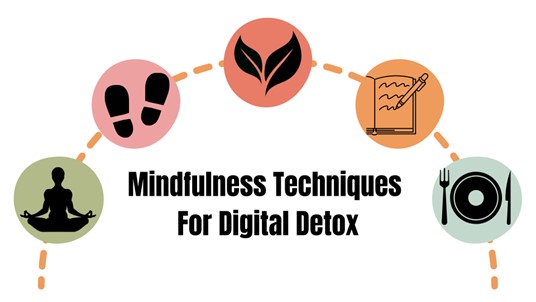
The main mantra is to sit quietly, focus on your breath, and clear your mind.
Meditation uses a combination of mental and physical techniques. They help relax your muscles and take your mind off pain.
You can try out multiple ways of meditation. However, breathing exercises and guided meditation are the most common.
Studies have shown that “meditation helps reduce stress levels by 31%” (Journal of Occupational and Environmental Medicine). Not just that! It helps improve attention span as well.
Relish the flavor of nutritious food but keep it slow.
Mindful eating is a dynamic method of managing your eating habits. It means you pay all the attention to the food. This includes steps like—
Savor each bite.You can prevent overeating as it makes you more aware of your hunger and fullness cues.
Research has shown how mindful eating can bring benefits. Experts say, eating mindfully helps with more effective psychological well-being, increased pleasure, and improved body satisfaction.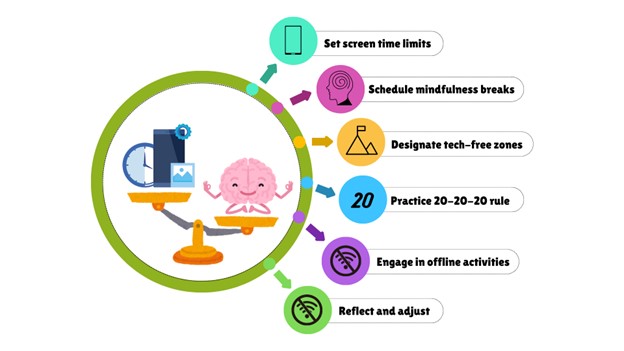 ow, it’s time to shape a balanced lifestyle.
ow, it’s time to shape a balanced lifestyle.
No matter how much you keep digital away, it’s still important in this era. So post-detox, you need to maintain a healthy relationship with technology.
Make sure you don’t get addicted to technology again. For this, keep the practice of mindfulness in your routine. It brings positive changes to your — personality, character, physical health, and mental health.
When using devices, pause for a while. Sense all the activities you’re doing. Point out every movement. Resist yourself from over-checking, clicking, typing, or scrolling the platforms.
Don’t forget to take a break for 10-20 minutes after every 30 to 60 minutes of tech exposure.
What is a digital detox?
A digital detox is the process of disconnecting yourself from electronics, mainly digital devices to reduce screen time.
How long should a digital detox last?
Commonly people take a 2-hour break from tech to improve real-world connectivity. However, a digital detox can last from minutes to years. It depends on your goals.
Can I still use my phone for work during a digital detox?
No. Avoid using your phone for work. This way, you can fully experience the benefits of a digital detox.
What are some immediate benefits of a digital detox?
Two common digital detox benefits are reduced stress and improved focus. These two benefits help improve your sleep as well.
How do mindfulness practices help in a digital detox?
Mindfulness practices help you stay present and manage cravings for digital stimulation.
What if I find it hard to stay off my devices?
Start with short breaks and gradually increase them to make it easier to stay off your devices.
How can I maintain a balanced digital lifestyle after a detox?
Set boundaries, schedule tech-free times, and use devices mindfully to maintain balance.
Screen time might keep you busy and help you pass the time. However, using your device for too long can affect your physical and mental health. Include real-life social relations. So, a digital detox is a must. You can pull out all the toxic effects of technology. Even if you need digital services, you can balance them with proper mindful practices. That way, you can enjoy benefits like—